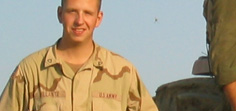Sergeant Adam Gray made it home from Iraq only to die in his barracks. Investigating his death, American RadioWorks pieces together a story of soldiers suffering psychological scars — because they abused Iraqi prisoners.
Audio:
Updated Jan. 2010 version:
Download the radio program or read the transcript.
Original Oct. 2008 version:
Download the radio program or read the transcript.
What Killed Sergeant Gray
When Adam Gray was just three years old, he told his parents he wanted to be a soldier someday. His mother, Cindy Chavez, says Adam used to love to visit a recruiting station near their house in Wisconsin.
He was a boisterous kid, prone to getting into trouble. His parents nicknamed him "The Bomber."
But once he enrolled in the Army, he was "heart attack serious," recalled his mother. "He wasn't going to do it for a stint just because he had nothing else to do. This was a life commitment."
Shortly after he turned 23, Adam Gray served a tour - about a year - in Iraq. He came home physically uninjured. He spent some time with his mother and stepfather in California. And then he went to a base in Alaska for more training. He said he wanted to go back to Iraq.
But on August 29, 2004, Gray was found dead in his barracks. A plastic bag was cinched around his neck, and can of Dust-Off - a cleaner used for electronic equipment - was lying beside him.
The Army ruled that his death was "accidental" - a result of inhaling chemicals to achieve a high (a practice known as "huffing").
That explanation seemed insufficient to Gray's family. It didn't seem like something the Adam they knew would have done.
Adam's mother and stepfather think something happened to him while he was overseas that changed him.
His stepfather, Roy Chavez, had noticed Adam looked different when he came home on leave.
"You know, one thing that really shocked me was when we picked him up at the airport, that he wasn't in his uniform," Roy said.
Roy says back when Adam finished basic training, "he walked up our driveway and he was in his full dress uniform."
But when he came home from leave in Iraq, "he just had his regular clothes on. I don't know if he was just sick and tired of it. 'I'm on leave. I don't want to deal with this anymore, you know, I just want to have a good time, see my mom, just be a regular, normal person.'"
Cindy Chavez said she thought immediately that Adam looked "troubled for what he saw, troubled for maybe what he had to do."
She says Adam was remote during his leave. He'd hole up in his room, and suddenly bolt out of the house for a run. He hardly talked about Iraq.
Continue to part 2 of What Killed Sergeant Gray.

Adam Stevenson saw military service as a way to challenge himself and gain financial independence from his family. Many of his friends in his hometown of Danville, Illinois had joined the Army to gain the same self-reliance, and to meet the strenuous demands of armed service.

Johnathan Millantz struggled to "soldier on" after he got back from Iraq. But the guilt he carried proved too big a burden.
Daniel Keller wanted to be a soldier from the time he was a young boy. Like Gray, once Keller finally joined the Army, he also took pride in being a professional soldier.
Tony Sandoval, a tanker with Sergeant Gray, took short video clips with his camera while stationed in Iraq. These clips show soldier life, from gun fights and fire control to horsing around with friends.
Author Joshua E. S. Phillips describes the process of telling Sergeant Gray's story in his Reporter's Notebook.
How does Post-traumatic Stress Disorder affect soldiers who have participated in torture?

